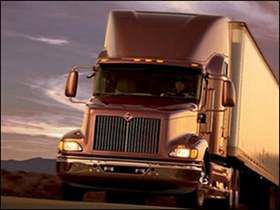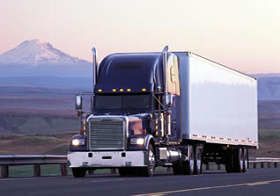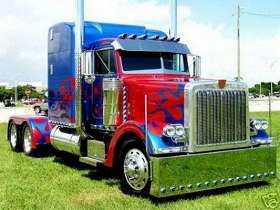No Recent Experience, Want To Get Back Into Trucking. Averrit Express
Topic 13728 | Page 2
Thanks Bucket,Frito, and James, That basicly somes up everything i wanted to know, just one other thing. can you relocate with Averrit once you start working for them?
Yes you can, as long as it is in the same devision, (truckload, LTL , etc..)
LTL:
Less Than Truckload
Refers to carriers that make a lot of smaller pickups and deliveries for multiple customers as opposed to hauling one big load of freight for one customer. This type of hauling is normally done by companies with terminals scattered throughout the country where freight is sorted before being moved on to its destination.
LTL carriers include:
- FedEx Freight
- Con-way
- YRC Freight
- UPS
- Old Dominion
- Estes
- Yellow-Roadway
- ABF Freight
- R+L Carrier

Frito do you have regional? James does ports, but where? Does that require twix or whatever letters for port? I'm not that far from Houston. Guess I need to learn more trucking terms! So if you don't do mostly drop & hook, does that mean live loads? Frito you mentioned a lot of free driving. Is that empty, or just pay from point a to point b? Also a lot of night driving! Is that from sitting all day for a load? I wouldn't mind driving until 9 or 10 at night or from 3 in the morning . I would not like to have to drive from 8 pm to 6 am. At least not on a regular daily schedule . The recruiter I talked to said "I would be with a trainer for six to eight weeks. That I would be learning the route and be no touch with mostly drop & hook. That's out of OkC! Could that be correct, or do I need to look elsewhere if that's what I want? Thanks for the info!
Regional:
Regional Route
Usually refers to a driver hauling freight within one particular region of the country. You might be in the "Southeast Regional Division" or "Midwest Regional". Regional route drivers often get home on the weekends which is one of the main appeals for this type of route.

I was hired as a regional driver. What does that mean? I've been all over the Averitt "map". Wisconsin to Florida, Pennsylvania to Deep South Texas.
Certain shippers that are security sensitive require a TWIC card. I've been to one that required it and since I didn't have one I was led around with an escort.
If it's not drop and hook , yes it's live load or unload. The experience can be quick and painless or a dragged out nucience where everyone seems to be either moving slowly, not at all, or slightly backwards. Invariably I personally seem to arrive at break time or shift change and more often than not it seems the latter. Perhaps you have engaged the recruiter about a dedicated account that is all drop and hook?
Free driving is when the load is going from say Memphis to North Chicago and the "Averitt HHG" miles are 475 and the actual gps miles are 525... You drive 50 miles for free... These are hypothetical numbers but it happens.
Night driving for me has primarily been petsmart loads... Arrive Dallas mid morning with a load... Get a multi stop petsmart assignment with a pickup at midnight with deliveries in south Texas at 3am , 6am, and 8 am ( who knew people unload dog food at 3am?). Procedure: transition to the Walmart parking lot in Ennis Tx near the D/C, reset your clock then start driving at 11:45pm. Sometimes you have to do that which you do not like. Any load could require all night driving to meet a delivery schedule. The benefit... Less traffic and closed weigh stations.
Your statement, "6-8 weeks to learn the route" sounds like a dedicated account... I've had no "route" per say although I've come to the realization that you are in fact running the same interstates when you begin to recognize the animal carcasses you saw days earlier, minus what the buzzards have enjoyed.
Shipper:
The customer who is shipping the freight. This is where the driver will pick up a load and then deliver it to the receiver or consignee.
Regional:
Regional Route
Usually refers to a driver hauling freight within one particular region of the country. You might be in the "Southeast Regional Division" or "Midwest Regional". Regional route drivers often get home on the weekends which is one of the main appeals for this type of route.
Interstate:
Commercial trade, business, movement of goods or money, or transportation from one state to another, regulated by the Federal Department Of Transportation (DOT).
Drop And Hook:
Drop and hook means the driver will drop one trailer and hook to another one.
In order to speed up the pickup and delivery process a driver may be instructed to drop their empty trailer and hook to one that is already loaded, or drop their loaded trailer and hook to one that is already empty. That way the driver will not have to wait for a trailer to be loaded or unloaded.
TWIC:
Transportation Worker Identification Credential
Truck drivers who regularly pick up from or deliver to the shipping ports will often be required to carry a TWIC card.
Your TWIC is a tamper-resistant biometric card which acts as both your identification in secure areas, as well as an indicator of you having passed the necessary security clearance. TWIC cards are valid for five years. The issuance of TWIC cards is overseen by the Transportation Security Administration and the Department of Homeland Security.

Thanks Frito, so a dedicated would be better than truck load? Yea I found a lot of companies do the HHG miles. Roughly zip to zip. I don't have a twic card but did get printed for background check to HM endorsement. I don't have a pre-hire and was ask to call when I get to school. I'm also checking Schneider, Swift, and Werner. Schneider has a Home Depot with home every other week covering Mo., Kansas, Ne, Co, but its team. About Averitt home time, do you take the truck home? Or do you park at a terminal? Why I ask is I live at least 150 miles from a terminal. That's a four hour round trip if I have to park. If its a 34 reset, guess I would have to make that part of trip planning. Oh yea I wanted to ask about per diem! Do they pay or do you have to keep up with time and file?
Sorry about all these questions and really appreciate all your help!
Later,
Terminal:
A facility where trucking companies operate out of, or their "home base" if you will. A lot of major companies have multiple terminals around the country which usually consist of the main office building, a drop lot for trailers, and sometimes a repair shop and wash facilities.
Pre-hire:
What Exactly Is A Pre-Hire Letter?
Pre-hire letters are acceptance letters from trucking companies to students, or even potential students, to verify placement. The trucking companies are saying in writing that the student, or potential student, appears to meet the company's minimum hiring requirements and is welcome to attend their orientation at the company’s expense once he or she graduates from truck driving school and has their CDL in hand.
We have an excellent article that will help you Understand The Pre-Hire Process.
A Pre-Hire Letter Is Not A Guarantee Of Employment
The people that receive a pre-hire letter are people who meet the company's minimum hiring requirements, but it is not an employment contract. It is an invitation to orientation, and the orientation itself is a prerequisite to employment.
During the orientation you will get a physical, drug screen, and background check done. These and other qualifications must be met before someone in orientation is officially hired.
Per Diem:
Getting paid per diem means getting a portion of your salary paid to you without taxes taken out. It's technically classified as a meal and expense reimbursement.
Truck drivers and others who travel for a living get large tax deductions for meal expenses. The Government set up per diem pay as a way to reimburse some of the taxes you pay with each paycheck instead of making you wait until tax filing season.
Getting per diem pay means a driver will get a larger paycheck each week but a smaller tax return at tax time.
We have a ton of information on our wiki page on per diem pay
TWIC:
Transportation Worker Identification Credential
Truck drivers who regularly pick up from or deliver to the shipping ports will often be required to carry a TWIC card.
Your TWIC is a tamper-resistant biometric card which acts as both your identification in secure areas, as well as an indicator of you having passed the necessary security clearance. TWIC cards are valid for five years. The issuance of TWIC cards is overseen by the Transportation Security Administration and the Department of Homeland Security.

I can't say whether dedicated is better than truck load or not. I think it depends on the driver and his/her expectations and the particular account itself.
I had prehire letters from several other companies, some you mentioned, but frankly at this point in the game, and in retrospect, wouldn't work for anyone other than Averitt. After a year, we will see.
Averitt equipment is parked on company property, it's not taken home. 150 miles is a long way and some positions have limitations as to how far away you can live.
Averitt doesn't pay a "per diem".
Prehire:
What Exactly Is A Pre-Hire Letter?
Pre-hire letters are acceptance letters from trucking companies to students, or even potential students, to verify placement. The trucking companies are saying in writing that the student, or potential student, appears to meet the company's minimum hiring requirements and is welcome to attend their orientation at the company’s expense once he or she graduates from truck driving school and has their CDL in hand.
We have an excellent article that will help you Understand The Pre-Hire Process.
A Pre-Hire Letter Is Not A Guarantee Of Employment
The people that receive a pre-hire letter are people who meet the company's minimum hiring requirements, but it is not an employment contract. It is an invitation to orientation, and the orientation itself is a prerequisite to employment.
During the orientation you will get a physical, drug screen, and background check done. These and other qualifications must be met before someone in orientation is officially hired.
Per Diem:
Getting paid per diem means getting a portion of your salary paid to you without taxes taken out. It's technically classified as a meal and expense reimbursement.
Truck drivers and others who travel for a living get large tax deductions for meal expenses. The Government set up per diem pay as a way to reimburse some of the taxes you pay with each paycheck instead of making you wait until tax filing season.
Getting per diem pay means a driver will get a larger paycheck each week but a smaller tax return at tax time.
We have a ton of information on our wiki page on per diem pay
You will need a TWIC to get into the ports, I run in Savannah all day long, without it you do not enter. I also started out truckload and as I said before Frito's info is spot on. I like being local more, also make i little more $$ i think. HM and TWIC are two different things you will need to go through the process again. it also cost more.
TWIC:
Transportation Worker Identification Credential
Truck drivers who regularly pick up from or deliver to the shipping ports will often be required to carry a TWIC card.
Your TWIC is a tamper-resistant biometric card which acts as both your identification in secure areas, as well as an indicator of you having passed the necessary security clearance. TWIC cards are valid for five years. The issuance of TWIC cards is overseen by the Transportation Security Administration and the Department of Homeland Security.

I looked at the Averrit site and they look like a great company to start out with. Does anyone have any info into this company?
Averrit, wants you to have a least 30 days of recent driving experience or attended one of their "approved schools". They really need to either upgrade their school list. (called them last week just to see, so the info is current)
New Reply:
New! Check out our help videos for a better understanding of our forum features

















Preview:
This topic has the following tags:
Averitt Express Choosing A Trucking Company








 TT On Facebook
TT On Facebook
As I understand it, and there may be some latitude in this, after a year in a given position as a new hire you can subsequently move about open positions within the company every 6 months. Supposedly current employees are given preferential consideration for an opening. This being said, I was able to change my initial domicile to a different domicile while in training with a single Qualcomm message.
Qualcomm:
Omnitracs (a.k.a. Qualcomm) is a satellite-based messaging system with built-in GPS capabilities built by Qualcomm. It has a small computer screen and keyboard and is tied into the truck’s computer. It allows trucking companies to track where the driver is at, monitor the truck, and send and receive messages with the driver – similar to email.